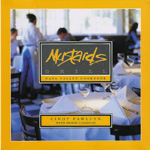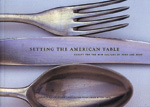|

The Napa Valley is lucky to have a rather good
assortment of bookstores. Bear in mind that many wineries have books
for sale, as does Cornucopia, the shop at Copia.
Book Warehouse
619 Factory Stores Dr.
Napa
(707) 258-8122
Bookends Book Store
1014 Coombs St.
Napa
(707) 254-7323
The Calistoga Bookstore
1343 Lincoln Ave.
Calistoga
(707) 942-4123
Copperfield’s Books
1303 First St.
Napa
(707) 252-8002
and
1330 Lincoln Ave.
Calistoga
(707) 942-1616
Learning Faire,
Children’s Books
& Workbooks
964 Pearl St.
Napa
(707) 253-1024
Main Street Books
315 Main St.
St. Helena
(707) 963-1338
Pacific Union
College Bookstore
Angwin Plaza
Angwin
(707) 965-6271
Books – Used and Rare
Glaser Edwin V Rare Books
503 Hunt St.
Napa
(707) 258-6281
Volume One Used Books
1405 Second St.
Napa
(707) 252-1466
|
Mustards Grill Napa Valley Cookbook
By Cindy Pawlcyn (with Brigid Callinan)
Ten Speed ($39.95)
The long-awaited Mustards Grill cookbook has, what with one thing
or another, been a while in the works. But it is here now in all
its four-color splendor. So was it worth the wait? Yes. Mostly.
Almost certainly.
If you have ever eaten at Mustards Grill then you already have
a pretty good introduction to the cooking, style and quirky humor
that is behind everything with the “Mustards Grill” name
on it. If the cookbook has a fault (and it has precious few) it
is that it goes a little too far in making sure that what you serve
will be exactly as it would appear if it came out of Mustards’
own kitchen. So when you look on the page for “French Country-Style
Vegetable Soup with Pistou” you are presented with a daunting
list of 20 ingredients plus a “refer to page...”that may
make you pause. Of course what you have there is a recipe for the
ham hock stock, one for the pistou and finally the recipe for the
soup. It’s not difficult to make by any means, it just looks
that way. And that’s unfortunate because most of the recipes
are well within the scope of a good home cook, and they have been
thoroughly tested and (unlike those of that poseur who screams “Bam!”
incessantly) they do work. It’s just that some of them seem
daunting when you first look at them. Get used to the style and
it becomes user-friendly very quickly.
Having said all that, let us also add that this is a beautiful,
captivating volume. The photographs are first rate and they mirror
the spirit of Mustards unerringly. The sidebars are worth the price
all by themselves, and the sections of “Oddities” and
desserts could be a book in itself. Pawlcyn and Brigid Callinan
have acquitted themselves with honor in this book and, minor grumbles
aside, it is one of the new standards to come from this season’s
collection of cookbooks.
Northern California History Weekends
By Lee Foster
Globe Pequot Press ($15.95)
There is a lot of information in this 248 page book, but what will
endear it to travelers is the design. Facts, recommendations, directions
and all the rest are laid out in a succinct, easy to follow format.
In the interest of simplicity some areas are a little weak (the
dining and lodging sections are sparse but well thought out), but
it is still one of the few guides that have made us sit up and take
notice. If you want some interesting history mixed in with your
travel plans, this is the book.
The Wine Bible
By Karen MacNeil
Workman Publishing ($19.95)
We have a confession to make: When we received a copy of this book
we were, to put it mildly, nonplussed. A quick glance at the bookshelves
showed at least fifty wine books of one sort or another, all published
within the last few years. Another wine guide? Hurrah. But that
was before. Before a dozen people said, unsolicited and at length,
how much they enjoyed Karen MacNeil’s new book, how easy it
was to use, how much they had learned from it and on and on and
on. And these were chefs, winery owners, people that knew good wine
books from bad, and could tell an imposter from a mile off. So what
did we do? We took a long hard look at it and darned if they weren’t
right.
One of our reviewers remarked that if you only read the sidebars
and the boxed items in this book (see ‘Who Came First’
on page 633 for a surprise) you’d still know more than 99 percent
of the people in the wine drinking world. And a lot of it is just
plain fun to learn. Actually, as long as this book is – close
to a thousand pages – it is an amazingly quick read. Still,
it would be the rare person who would read it straight through.
A book like this is designed for jumping about, from the wines of
Portugal to the food of Germany with about a million things in-between.
With as much information as “The Wine Bible” contains,
it might be easy to suppose that this would be a ponderous work.
On the contrary it is a delightful romp through wineries, kitchens,
barrel cellars, vineyards and anywhere else wine or wine knowledge
lurks. MacNeil is a talented writer and an equally talented master
of organization and balance. Spend an evening or two with her book
and you’ll be amazed at how much you learn, almost by osmosis.
Afternoon Delights
By James McNair & Andrew Moore
Chronicle Books ($17.95)
The wonderful thing about a James McNair cookbook is that they
work. Pick a recipe, get the ingredients, follow the directions
and you will be successful if you have even a modicum of kitchen
skills. This, the latest in a long series of single-subject cookbooks
(see “The Interview” in this issue), devotes itself to
those wonderful treats “just like your mother used to make.”
Easy to follow, handsomely photographed by talented Bay Area photographer
Karl Petzke, and enjoyable to read (we were even enamored of the
dedication and acknowledgements) this is a true complement to the
previous titles. From Seven-Layer Bars and Madeleines to Blondies
(wonder where they came from? See page 59) and Banana Nut Bread
this book tempts, delights and will make you smell the fresh baked
cookies before you even turn on the oven. Another favorite McNair
title: New Pizza, also from Chronicle Books. Do yourself a favor
and get one of each. You will be well rewarded for your efforts.
The Professional Chef, 7th Edition
The Culinary Institute of America
John Wiley & Sons, Inc. ($65)
This is the Holy Grail for many professional chefs, 1036 illustrated
pages that are the distillate of a legion of CIA instructors, chefs
and other professionals. Culinary icon Paul Bocuse stated that “I
am certain that this new edition will quickly become the bible for
all chefs.” He is probably right.
One thing this 7th Edition is not is a glossy guide through culinary
regions or casual reading for the armchair cook where the author
spins tales of his or her time in Venice or Seillans. Where some
cookbook authors would still be telling you about the flowers they
planted outside their kitchen window, this book gets serious.
I am sure that you could run a perfectly respectable restaurant
or bistro without a copy of this book on the shelves, but why would
you want to? In one large volume it serves up all the information
you will need for probably 90 percent of the questions you would
have, from the recipe for Gremolata to the way meat is graded. Too
much information for the average amateur chef? Probably, but this
book was made for real pros and it never lets you forget it.
Nuts – Sweet and Savory Recipes
By Tina Salter
Celestial Arts (Ten Speed) ($14.95)
Not surprisingly, Diamond of California (the world’s leading
marketer of nuts) is the driving force behind this attractive cookbook.
There is handsome photography by Holly Stewart and Robert Holmes,
and well-written and useful text by cookbook veteran Tina Salter.
There is also a long list of famous and talented contributors who
shared their recipes and expertise. Does the world need an entire
cookbook devoted to nuts? That is your decision, but if it does
then this is as fine an example as we have seen.
|
 |
Setting the
American Table
Essays for the New Culture of Food
and Wine
Copia ($24.95)
This is the first offering under the Copia imprint, a handsome
collection of essays by such authors as Karen Moss, Lionel Tiger,
Colman Andrews, Michael Webb and others, with a cogent forward by
Copia director Peggy Loar that ties it together as it states the
purpose of what will hopefully be a series of similar collections.
The design is a striking mix of photography, art and other images
that make for an overall look that befits Napa’s latest spectacular,
Copia itself.
Red and White
By Max Allen (Photography by Adrian Lander)
Wine Appreciation Guild ($24.95)
The subtitle to this book is “Wine Made Simple” and that
it does, in a seductive format that uses lavish photographs and
a casual prose style to inform the reader in such a comfortable
manner that when you reach the last page you have absorbed all sorts
of information and you haven’t even noticed that you were being
educated as you perused the pages. Free of vintage charts, lists
of names and places and dates and even tasting notes, it is wine
education made basic, but with plenty of interesting facts and observations
that will leave even the experienced oenophile feeling as if they
too have learned quite a bit along the way.
Great Wine Made Simple
By Andrea Immer
Broadway Books ($25)
Wary as we have become of books that profess to make the most complex
subject (nuclear fission! Eastern philosophy!) accessible for even
the most intellectually challenged, we like Andrea Immer’s
new book. For one thing the author, one of that elite international
group that qualifies as a Master Sommelier, has the knowledge and
experience to back it up and make the subject understandable. We
might wonder at her choice of words like “yucky” to describe
the taste of some high-end wines, but overall the book accomplishes
what it sets out to do; read it and you will, inevitably and inescapably
(and enjoyably), understand wine better and appreciate it more.
It even tells you how to use a waiter’s corkscrew the correct
way. That’s worth the price of admission right there. Read
this and Karen MacNeil’s book and prepare to go forth and conquer
the world of wine!
|
